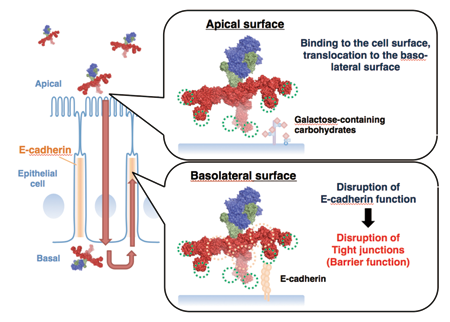Many bacterial toxins can severely damage the host, even at very low concentrations. Most bacterial toxins are enzymes that act catalytically and with high specificity on functional host cell molecules, thereby markedly modulating host homeostasis. The toxins are also often highly efficient in accessing their target molecule in the host. The ingenious transport systems involved often exploit the fundamental host machinery of membrane trafficking and the functions of intracellular organelles. Therefore, studies seeking to elucidate toxin trafficking could provide us with valuable information about basic cellular function, as well as aiding our understanding of the pathology induced by these toxins and helping us to develop effective therapeutic strategies against them. We are currently engaged in studying the structure and function of the botulinum neurotoxin complex, which must pass down the digestive tract and cross the epithelial barrier lining the intestine to cause food-borne botulism.

Hypothetical model for intestinal absorption of botuliunum neurotoxin complex (type B 16S toxin). We propose a three-step mechanism by which the botulinum neurotoxin complex breaches the intestinal epithelial barrier. First, apically located 16S toxin binds to intestinal epithelial cells via the interaction of HA (hemagglutinin) component and galactose containing-glycoconjugates, and is transcytosed. Then, once located in the basolateral compartment, HA component binds to E-cadherin, and thereby disrupts the paracellular barrier. Finally, a large amount of toxin accumulates in the basolateral area via paracellular movement.